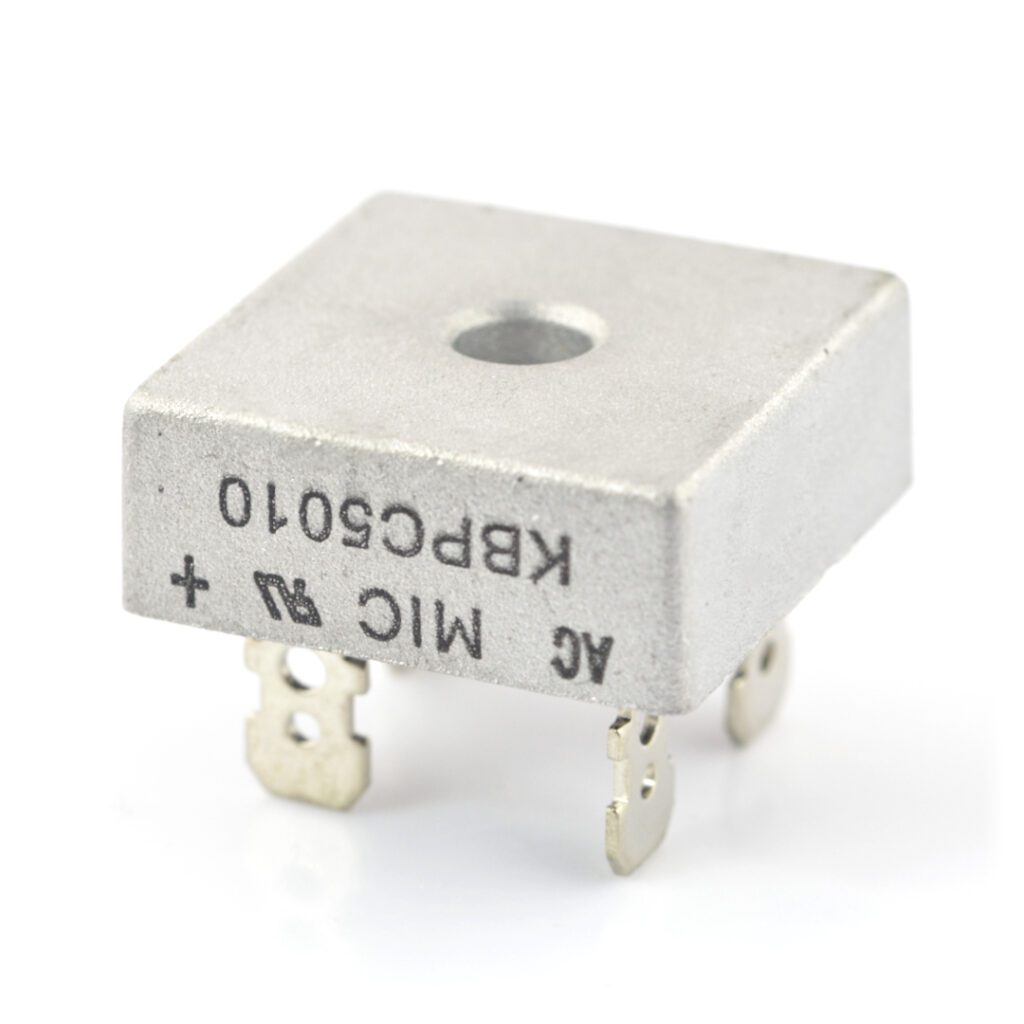Table of Contents:
From the description of the principle of operation of most of the electronic circuits we deal with in practice, we can learn that they need a DC voltage power source to operate. We can get DC voltage from a battery or from a power supply converting AC voltage to DC voltage. In such power supplies, after lowering the voltage to a suitable value, the first stage of converting the time course of the voltage takes place, which is to straighten it. To do this, we use silicon diode bridges, such as the following. KBPC5010, on the example of which we will discuss the principle of operation of a diode bridge for rectifying an AC voltage into a unidirectional AC voltage.
Bridge in electronics
In electronics, when we describe a circuit section in a bridge topology, we mean a circuit section that has four terminals. This also applies to a diode bridge, where an alternating voltage is converted into a unidirectional alternating voltage, which should be distinguished from a direct voltage, since this is only one step in the process of converting this voltage into a direct voltage.
Structure and principle of operation of a diode bridge
The rectifier bridge is formed by four diodes and a load resistor, which is the target load. The four diodes are connected in a closed-loop arrangement to convert AC current into unidirectional AC current. The main advantage of this circuit is that it does not require the use of a center-tapped transformer, which is usually more expensive than a transformer with a standard winding without a center-tap. This reduces the cost and size. An input voltage in the form of an alternating sinusoidal voltage, also known as AC voltage, is applied to terminals A and B. At the output of the bridge, the diodes are arranged in such a way that during each half-period of the positive period of the sine wave, the current conducts through diodes D1 and D3, while diodes D2 and D4 are in the inverted state. During the negative half-period, the situation is analogous, but then diodes D2 and D4 are conducting, while D1 and D3 are in the negative state.
As a result, the voltage at the output of the bridge, and thus at the load connected to the output, takes the form of a unidirectional alternating voltage. In fact, at the moment of changing the polarity of the supply voltage, a transient charge appears on the diodes, causing gentle reverse conduction of the diode, but this is a phenomenon with a negligible effect on the operation of the diode bridge, so it can really be ignored.
Features of a diode bridge
Attention should be paid to several parameters that are particularly crucial from the point of view of design calculations for diode-bridge circuits. These include the ripple factor, which determines the level of smoothing of the DC voltage at the output of the rectifier. It is determined by the noise level of the DC voltage output, which contains a negligible level of ripple. If, on the other hand, we have very high ripple at the output, we then say that we are dealing with a DC voltage with high ripple. In mathematical terms, the ripple factor is defined as the ratio of the ripple voltage to a perfectly pure DC voltage, free of noise. Typically for diode bridges, the ripple factor is 0.48. The peak reverse voltage is the maximum voltage that a single diode can withstand in the forward state when a higher voltage is applied to the cathode relative to the anode of the same diode. As a reminder, in the positive half-period of a sine wave, diodes D1 and D3 are in the conduction state, while diodes D2 and D4 are in the reverse state. In the negative half-period of the sine wave, pairs of these diodes swap conducting states.
Diode bridge efficiency
The efficiency of a diode bridge determines how efficiently a diode bridge converts AC current into unidirectional DC current. It is defined as the ratio of DC output power to AC output power. The maximum efficiency of a bridge rectifier is about 81%.
KBPC5010 diode bridge - key technical parameters
Mechanical parameters:
- Housing: Metal, electrically insulated
- Epoxy resin: UL 94V-0 flame retardant
- Terminals: Plated Faston 0.25″ (6.35 mm) terminals, soldered in accordance with MIL-STD-202E, guaranteed method 208
- Polarity: denoted by the letter A
- Mounting position: Any.
- Weight: 17 g
Acceptable electrical parameters:
- Maximum peak reverse voltage: Vrrm = 1000 V
- Maximum RMS bridge input voltage: Vrms = 560 V
- Maximum DC blocking voltage: VDC = 1000 V
- Maximum average rectified output current at Tc = 55*C: Io = 50 A
- Maximum surge current: Ip = 400A
- Maximum voltage drop on a single diode for 25A DC current: 1.1 V
How useful was this post?
Click on a star to rate it!
Average rating 0 / 5. Vote count: 0
No votes so far! Be the first to rate this post.




















